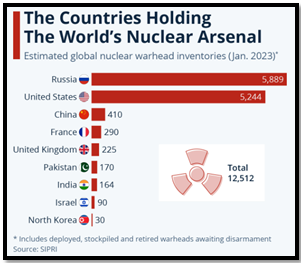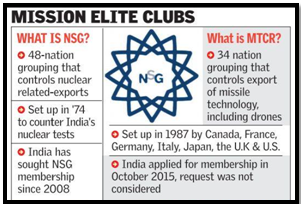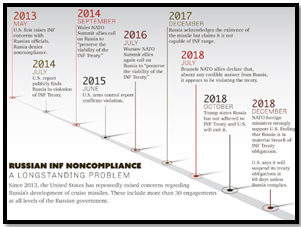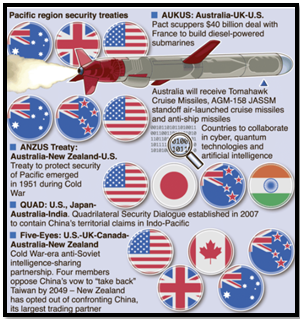THE GLOBAL NUCLEAR ORDER IS UNDER STRAIN
Syllabus
- GS2: Bilateral, Regional and Global Groupings and Agreements involving India and/or affecting India’s interests.
Why in the News?
- Recently, changing geopolitics and strained U.S.-Russia relations have eroded Cold War-era treaties, challenging the global nuclear order (GNO).
- The emergence of two nuclear peer rivals, China’s assertiveness, and shifting U.S. priorities raise concerns about strategic stability and non-proliferation efforts.
Source: statista.org
Challenges to the Global Nuclear Order (GNO)
- The legitimacy of any global order, exemplified by the Global Nuclear Order (GNO), relies on two critical conditions
- First convergence among major powers and
- Second the perception of its outcomes as a global public good.
- Presently, the GNO faces significant strain, questioning its continued effectiveness.
Lessons from the Cold War for Global Nuclear Order (GNO)
Cold War Origins
- The GNO originated during the Cold War, with the U.S. and U.S.S.R. at the helm.
Post-Crisis Realizations
- After the Cuban Missile Crisis in 1962, Kennedy and Khrushchev recognized –
- First – the need for bilateral mechanisms to prevent nuclear escalation.
- Second – They also acknowledged the danger of nuclear weapons, leading to the establishment of the GNO.
GNO Foundation
- The GNO was founded on the lessons of the Cold War, emphasizing nuclear restraint and prevention of proliferation.
Crisis Communication and Arms Control
- During the Cuban Missile Crisis, a secret communication channel between President Kennedy’s brother, Robert Kennedy, and Soviet Ambassador Anatoly Dobrynin played a crucial role in resolving the crisis.
- To prevent future misunderstandings, the leaders established the hotline in 1963, allowing direct communication.
- This hotline, later upgraded into nuclear risk reduction centers, paved the way for arms control negotiations, as both superpowers aimed to manage their nuclear arms race and ensure strategic stability.
The Birth of the Nuclear Suppliers Group (NSG)
Background
- In 1974, India conducted a peaceful nuclear test, raising global concerns.
- This prompted key nations – U.S., U.S.S.R, U.K., Canada, France, Japan, and West Germany – to address the risk of nuclear technology misuse.
London Club’s Formation
- These nations formed the “London Club” to establish controls on nuclear exports, aiming to prevent peaceful nuclear explosives (PNEs).
- However, the name didn’t stick.
Source: KmhouseIndia
Nuclear Suppliers Group (NSG)
- Evolution led to the creation of the Nuclear Suppliers Group (NSG), now comprising 48 countries.
- The NSG enforces shared guidelines on exporting nuclear materials, equipment, and technologies, ensuring their peaceful use.
Soviet Commitment to Global Nuclear Order
- Despite the close ties between the Soviet Union and India, evident in the 1971 Indo-Soviet Friendship Treaty, the USSR remained dedicated to preserving the Global Nuclear Order.
- It actively participated as a founding member in the formation of the London Club.
Global Nuclear Order’s Success
- The GNO has held up rather well, especially in two areas.
First: Nuclear Weapons Taboo Since 1945
- For 75 years, there’s been a worldwide taboo against using nuclear weapons.
- Whether it’s due to the S.-USSR arms control efforts or just sheer luck is up for debate.
- The remarkable fact remains—despite the nuclear age challenges, humanity has avoided catastrophic self-destruction.
Second: Non-Proliferation Success
- Contrary to 1970s forecasts of 20 nuclear-armed nations, only India, Israel, North Korea, and Pakistan joined the original five—U.S., U.S.S.R., U.K., France, and China—by 1968.
- Post-Cold War, non-proliferation cooperation continued, focusing on denuclearizing Belarus, Ukraine, and Kazakhstan.
- The commitment to limiting nuclear-armed states has helped maintain relative stability, with Moscow and Washington playing key roles in achieving this shared objective.
NPT Perpetuity and Arms Control Progress
- The NPT, initially a 25-year pact, was extended indefinitely in 1995.
- However, the arms race between the U.S. and U.S.S.R. persisted, with arsenals ballooning from 28,000 bombs in 1962 to over 65,000 in the early 1980s.
- Despite this, dialogues and agreements somewhat managed the race.
- Post-1980s, U.S. and Soviet arsenals significantly decreased, now below 12,000 bombs.
- This reduction, though partially attributed to the Cold War’s end and the U.S.S.R.’s breakup, signals progress in disarmament efforts.
Strategic Stability in a Bipolar World
- The two major nuclear powers, the U.S. and the U.S.S.R., agreed on “strategic stability” centered on a secure second-strike capability, deterring any initial attacks and ensuring stability.
- Arms control talks established parity in strategic capacities, fostering stability in the arms race.
- Fail-safe communication links further secured crisis management stability.
- These principles, effective during the Cold War, face scrutiny in today’s complex geopolitical landscape.
Shifting Nuclear Dynamics
- In today’s nuclear landscape, the S. encounters a rising China, assertive in reclaiming influence globally and regionally.
- Unlike the Cold War, this rivalry unfolds amidst economic interdependence, with China emerging as an economic and technological peer.
- Tensions escalate over the U.S. naval presence in the South and East China Seas, and China.
- Since the 1996 Taiwan Strait crisis, has significantly enhanced its naval and missile capabilities, marking a distinct shift in global power dynamics.
Source: Defence.gov
Unravelling Treaties: A New Nuclear Reality
- In the evolving geopolitical landscape, S.-Russia treaties face challenges.
- The S. exited the Anti-Ballistic Missile (ABM) Treaty in 2002 and the Intermediate-Range Nuclear Forces (INF) Treaty in 2019, citing Russian violations.
- The last standing pact, New START, set to expire in 2026, faces uncertainty after verification meetings stalled during the COVID-19 outbreak.
- Strategic stability talks initiated in 2021 collapsed amid the Ukraine war.
- Russia’s de-ratification of the CTBT last year raises fears of nuclear testing resumption.
- Amidst deteriorating U.S.-Russia ties, the emergence of two nuclear peer rivals exploring more usable weapons reshapes global dynamics.
- Russian nuclear warnings in the Ukraine conflict revive concerns, challenging old notions of strategic stability.
Source:Lotusarise
Evolution of Nuclear Pragmatism
- The era of Cold War cooperation on non-proliferation has ended, coinciding with the aging of nuclear technology.
- The U.S., historically pragmatic, overlooked Israel’s nuclear pursuits in the 1960s-70s and China’s aid to Pakistan in the 1980s.
- The AUKUS deal (Australia, U.S., U.K.), providing nuclear submarines to non-nuclear Australia, triggers NPT community concerns, highlighting a shift in nuclear attitudes and policies.
South Korea’s Nuclear Dilemma
- In the 1970s, South Korea thought about a nuclear weapons program due to U.S. withdrawal from Vietnam.
- Despite France withdrawing its reprocessing plant offer under U.S. influence, South Korea opted to join the NPT.
- Current polls show 70% favoring a national nuclear deterrent and 40% supporting the reintroduction of withdrawn U.S. nuclear weapons (1991).
- South Korea struggles with its nuclear stance amid changing dynamics.
U.S. Intervention in Taiwan’s Nuclear Ambitions
- From 1977 to 1988, the U.S. undermined Taiwan’s nuclear program while improving ties with China.
- Despite Japan’s historical anti-nuclear sentiment, a recent shift is evident with Japan planning to double defense spending in the next five years.
Shifts in Nuclear Dynamics
- During the Cold War, the S.’s nuclear umbrella strengthened ties with European allies.
- Today, S. focus on domestic issues raises doubts among allies, especially in East Asia, about extended deterrence.
- Japan, South Korea, and Taiwan possess the technical capacity for independent nuclear deterrence with political will.
- S. pragmatism may lead to the realization that independent nuclear capabilities are a viable strategy in the face of China’s rivalry, challenging the stability of the Global Nuclear Order.
| Cuban Missile Crisis (1962)
· The Cuban Missile Crisis in 1962 was a 13-day confrontation between the U.S. and USSR when Soviet nuclear missiles were discovered in Cuba. · The U.S., fearing a first strike, imposed a naval blockade. · Tensions escalated, but through diplomatic negotiations, the USSR agreed to remove the missiles in exchange for a U.S. pledge not to invade Cuba and a secret removal of U.S. missiles from Turkey. Nuclear Suppliers Group (NSG) · Established in 1975. · Despite seeking membership since 2008, India is not currently a member. · The NSG operates under Trigger List and Dual-Use Guidelines to control specific items and evaluate those with both civilian and military applications. · Membership: NSG has 48 member countries, with India facing opposition, particularly from China. 1971 Indo-Soviet Friendship Treaty · Signed in August 1971, the treaty cemented a close partnership between India and the Soviet Union. · Both parties committed to peaceful coexistence, non-aggression, and preventing use of their territories against each other. · The treaty aimed to counter Pakistani ties with China and the United States, providing India critical military support during the Bangladesh Liberation War. |
Source
- https://nuclearsuppliersgroup.org/en/
- https://epaper.thehindu.com/reader?utm_source=Hindu&utm_medium=Menu&utm_campaign=Header
Mains Practice Question
Q. Discuss the origins and key components of the Global Nuclear Order (GNO) established during the Cold War, emphasizing the convergence between the U.S. and the U.S.S.R. in preventing nuclear tensions and curbing proliferation.

 Source: statista.org
Source: statista.org Source: KmhouseIndia
Source: KmhouseIndia Source: Defence.gov
Source: Defence.gov Source:Lotusarise
Source:Lotusarise

